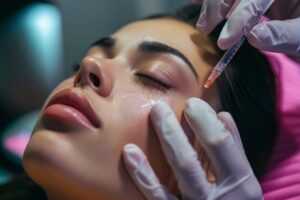La inflamaciÃģn del tejido mamario masculino puede ser una condiciÃģn difÃcil de afrontar por los jÃģvenes. Resulta incÃģmodo y produce vergÞenza, y por ello los padres deben ocuparse del problema, para que puedan tener una adolescencia tranquila. Informarse es la mejor forma de enfrentar la situaciÃģn, por ello queremos hablarte sobre la ginecomastia en adolescentes o puberal, hablaremos sobre quÃĐ es, las causas y cÃģmo se elimina.
Tabla de contenidos
ToggleÂŋQuÃĐ es la ginecomastia en adolescentes?
La ginecomastia en la pubertad es una condiciÃģn en la que varones que estÃĄn en la etapa de la pre-adolescencia o adolescencia, desarrollan senos similares a los de las mujeres.
El tejido mamario en exceso puede comenzar a aparecer en niÃąos de 10 aÃąos, y a mÃĄs tardar se puede presentar a los 15 aÃąos.
Si tu hijo estÃĄ pasando por esta situaciÃģn y te has preguntado Âŋa quÃĐ edad desaparece la ginecomastia en adolescentes? Es importante que sepas que en la mayorÃa de los casos esta condiciÃģn se elimina entre los 6 meses y los 2 aÃąos luego de su apariciÃģn, sin necesidad de algÚn tratamiento. A mÃĄs tardar esto sucede al terminar el perÃodo de la adolescencia.
Si al finalizar el proceso de crecimiento, el tejido mamario permanece en forma de senos, ya se puede considerar que la condiciÃģn es permanente.
Generalmente, los cambios hormonales son los responsables del crecimiento de los senos masculinos en la adolescencia, pero tambiÃĐn pueden existir otras causas, aunque son la minorÃa de los casos.
No se debe confundir la ginecomastia puberal con la pseudoginecomastia, la cual puede ser producto de acumulaciÃģn de grasa en la zona, posiblemente por sobrepeso.
ÂŋCÃģmo se quita la ginecomastia en adolescentes?
Como hemos explicado, en la adolescencia la ginecomastia es generalmente una condiciÃģn transitoria. Pero si luego de finalizar esta etapa, no desaparece el tejido mamario en varones, serÃĄ necesario pensar en un tratamiento.
Si ya se hizo una evaluaciÃģn del paciente y se determina que su condiciÃģn no es una pseudoginecomastia, entonces es importante comenzar a pensar en el tratamiento que pueda eliminar el exceso de tejido en la zona del pecho.
Lo primero que el especialista debe encontrar es la causa del problema, si deseas una evaluaciÃģn profesional puedes pedir una cita. En caso, que la razÃģn por la cual se generÃģ la ginecomastia puberal requiera de algÚn tratamiento especÃfico el mÃĐdico deberÃĄ indicarlo.
FÃĄrmacos
En ciertos pacientes adolescentes, se puede usar un tratamiento con fÃĄrmacos que puedan regular los niveles hormonales, reduciendo la cantidad de estrÃģgenos, lo cual puede ayudar a reducir el exceso de tejido mamario en varones.
CirugÃa de ginecomastia
Pero en la mayorÃa de los pacientes se requiere una operaciÃģn de ginecomastia, que es una cirugÃa para corregir la condiciÃģn y eliminar el exceso de tejido mamario.
Dependiendo de la gravedad del caso se decidirÃĄ cuÃĄl es el mejor procedimiento para el paciente.
Cuando se trata de casos leves a moderados, el tratamiento ginecomastia puberal puede implicar una liposucciÃģn tradicional, en conjunto con una liposucciÃģn asistida con ultrasonido. Y, adicionalmente una cirugÃa para eliminar el exceso de tejido, segÚn sea necesario.
En estos pacientes la liposucciÃģn tradicional utiliza una cÃĄnula que se introduce para eliminar toda la grasa en la zona de los senos. Se asiste con una liposucciÃģn con ultrasonido porque funciona para descomponer algunas cÃĐlulas y tejidos que luego se pueden succionar junto con la grasa.
Y por Último, si con la liposucciÃģn no se pudo recuperar la forma se recurre a un corte en forma de medio cÃrculo alrededor de la areola, para retirar a travÃĐs de esa incisiÃģn el tejido mamario excedente para luego recuperar la forma del pecho.
Cuando hay demasiado tejido mamario en la zona, podrÃamos hablar de casos severos de ginecomastia en adolescentes. Y en estos pacientes no sÃģlo funciona hacer la incisiÃģn y quitar el tejido. Porque resulta que al retirar el tejido les queda piel colgando que serÃĄ necesario eliminar para darle nuevamente aspecto masculino al pecho.
En estos pacientes se puede quitar la piel haciendo un corte circular alrededor de toda la areola, y luego uniendo de nuevo con el borde de la areola. De esta forma la piel extra es retirada y se recupera la forma del pecho. Si el paciente presenta un exceso de piel importante o el caso es complicado, es posible que el cirujano decida utilizar tÃĐcnicas empleadas para reducir los senos en mujeres.
Si su hijo aÚn no ha llegado a la adolescencia y desea saber sobre un tratamiento ginecomastia en niÃąos, lo mÃĄs recomendable es consultar con el pediatra. Esto debido a que aÚn es pequeÃąo y es importante primero conocer la causa para atacar el problema subyacente.

Causas de la ginecomastia en adolescentes
Desequilibrio hormonal
La principal causa de la presencia de ginecomastia en adolescentes es fisiolÃģgica; producto de un desequilibrio en las hormonas, en el que se estimula la producciÃģn de estrÃģgenos y se inhibe la de andrÃģgenos. Cuando se producen en hombres, mÃĄs hormonas femeninas (estrÃģgenos) las consecuencias pueden ser la apariciÃģn de senos masculinos.
Este desequilibrio puede ser temporal, propio de todos los cambios que se producen durante la pubertad. Por lo cual, pasado un tiempo tiende a desaparecer. Sin embargo, para muchos adolescentes que sufren por esta situaciÃģn, la ginecomastia a los 17 aÃąos todavÃa estÃĄ presente, produciendo ansiedad, depresiÃģn, estrÃĐs y baja autoestima.
Sobrepeso u obesidad
AdemÃĄs de los cambios hormonales, existen otras causas ginecomastia en adolescentes. Es posible que sea producto o empeore en pacientes que sufren de sobrepeso u obesidad, o por causas genÃĐticas. TambiÃĐn pueden ser producto del efecto secundario por el consumo de algÚn fÃĄrmaco o medicamento.
Tumores o condiciones genÃĐticas
En un porcentaje muy bajo de los casos de ginecomastia, la causa puede ser la presencia de un tumor. O por condiciones genÃĐticas existentes, como el llamado sÃndrome de Klinefelter, en el que los varones tienen un cromosoma X adicional.
Conocer mÃĄs acerca de la ginecomastia en adolescentes o puberal, sus causas y cÃģmo se elimina, puede ser el punto de partida para apoyar a tu hijo adolescente que estÃĄ sufriendo por esta condiciÃģn y ayudarlo a encontrar una soluciÃģn adecuada para su caso particular.









